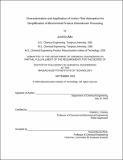Characterization and application of vortex flow adsorption for simplification of biochemical product downstream processing
Author(s)
Ma, Junfen, 1972-
DownloadFull printable version (948.1Kb)
Alternative title
Characterization and application of VFA for simplification of biochemical product downstream processing
Other Contributors
Massachusetts Institute of Technology. Dept. of Chemical Engineering.
Advisor
Charles L. Cooney.
Terms of use
Metadata
Show full item recordAbstract
One strategy to reduce costs in manufacturing a biochemical product is simplification of downstream processing. Biochemical product recovery often starts from fermentation broth or cell culture. In conventional downstream processing, the initial steps are clarification, concentration, and purification. Simplification of downstream processing may be achieved by reducing the number of unit operations. Integrative technologies seek to combine steps into a new single unit operation, thereby tightening the whole process. Vortex flow occurs in the annular gap between an inner rotating solid cylinder and an outer stationary cylindrical shell. Above a critical rotation rate, circular Couette flow bifurcates to a series of counter-rotating toroidal vortices. By suspending adsorbent resin in the vortices, a novel unit operation, vortex flow adsorption (VFA), is created. In VFA, the rotation of the inner cylinder facilitates the fluidization of the adsorbent resin. In addition, VFA has high fluid voidage so that it can be used to recover biochemical products directly from fermentation broths or cell homogenates without removing cells or cell debris first. VFA was characterized through two experimental approaches, tracer residence time distribution (RTD) study and breakthrough capacity measurements, and two modeling approaches, a one-dimensional dispersion convective model and a two-region vortex flow model. It was concluded that the axial dispersion in the vortex flow system is distinct in different vortex flow regimes. (cont.) The effect of the operating variables, including the rotation rate of the inner cylinder, the axial loading flowrate, and the adsorbent volume fraction, on the performance of VFA was explored. In this research, recombinant human (cl-antitrypsin ([alpha]l-AT) was expressed in Escherichia coli as a C-terminal fusion to a modified intein containing a chitin-binding domain. The VFA results indicated that VFA not only captures the fusion protein from crude cell extract containing cell debris but also purifies ocl-AT. Therefore, vortex flow adsorption is an integrative technology to combine the primary clarification, concentration, and purification steps to simplify conventional downstream processing.
Description
Thesis (Ph. D.)--Massachusetts Institute of Technology, Dept. of Chemical Engineering, 2003. Includes bibliographical references (p. 173-180). This electronic version was submitted by the student author. The certified thesis is available in the Institute Archives and Special Collections.
Date issued
2003Department
Massachusetts Institute of Technology. Department of Chemical EngineeringPublisher
Massachusetts Institute of Technology
Keywords
Chemical Engineering.